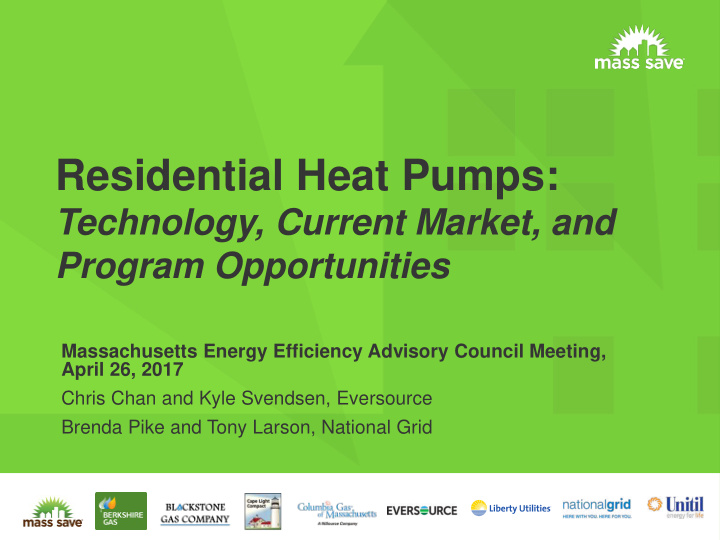



Residential Heat Pumps: Technology, Current Market, and Program Opportunities Massachusetts Energy Efficiency Advisory Council Meeting, April 26, 2017 Chris Chan and Kyle Svendsen, Eversource Brenda Pike and Tony Larson, National Grid
Outline Heat Pump (HP) Technology HP Program Savings and Participation Key Evaluation Findings Program Design Changes 2
What Is a Heat Pump (HP)? Uses electricity to transfer ambient heat at a higher temperature from or to the home Instead of converting electricity (directly through a resistor heating element) or burning fossil fuels to produce heat Efficiency is a function of outdoor temperature Source: http://celticgreenenergy.co.uk/how-a-heat-pump-works 3
Heat Pumps Generally Have Low Operating Costs and Emissions (Heating) CO 2 Cost emissions per per MMBtu MMBtu (lbs) Fuel Cost Efficiency PA internal analysis. Costs for oil and propane are the average retail Heat Pump $0.20/kWh 2.5/3.5 prices for the 2016-17 winter season published by MA Electrical Resistance $0.20/kWh 1.0 Executive Office of Energy and Environmental Affairs. Emissions Natural Gas $1.28/therm 0.85 factors (CO 2 ) from MA Department of Environmental Oil $2.47/gallon 0.80 Protection. 4 Propane $2.96/gallon 0.85
Heat Pump Program Savings 2016-2018 Three-Year EE Plan TRM Estimated Maximum Energy HP Technology Savings/Year and Load Reduction (Standard Efficiency to High Efficiency) 1,080 kWh Central heat pumps 0.65 kW (ducted systems) (2.8-ton unit) 330 kWh Mini-split heat pumps 0.45 kW ( MSHPs ) (1.0-ton unit) <55 gallons >55 gallons* Heat pump water heaters 1,650 kWh 344 kWh ( HPWHs ) 0.34 kW 0.14 kW * New offering introduced in 2017. Photo sources: https://www.oregon.gov/energy/At-Home/Pages/Ducted-Heat-Pumps.aspx, 5 http://www.justminisplits.com/products/dual_zone_mitsubishi_mini_split.php, http://www.ecosmartinc.com/catwheat21.php.
Heat Pump Program Rebate Volume Equipment 2014 2015 2016 Type Central HPs 691 902 700 MSHPs* 6,520 6,050 7,484 * Number of outdoor units. Source: 6 https://www.energystar.gov/products/heating_cooling/ductless_heating_cooling
How Are Customers Using MSHPs? MA customer survey 430 participants from 2013-2014 More than half got an energy audit For comfort (68%), not for energy savings For A/C and as Source: http://www.trueblueheatandair.com/services/mini-split- ductless-air-conditioners/ supplemental/secondary heat Source: The Cadmus Group, Inc. Ductless Mini-Split Heat Pump Customer Survey Results , August 2014. 7
How Are Customers Using MSHPs? 2016 MA impact study affirms that MSHPs are being used intermittently year-round and secondarily with existing heating systems (comfort over savings) Equivalent Full Equipment Load Hours per Year Type Cooling Heating MSHPs (Study 218 451 Average) MSHP (Study Top 25 th 499 1,117 percentile) Central A/C and HPs 360 1,200 (TRM) MSHP is not being used as a primary source of heat Source: The Cadmus Group, Inc. Ductless Mini-Split Heat Pump Impact Evaluation , December 30, 2016. 8
Boosting MSHP Savings without Sacrificing Customer Comfort Maximize MSHP usage for heating as the key driver of savings Optimize configuration and operation so MSHPs better complement existing heating systems and reduce overall heating costs But customer concerns over cost and aesthetics Also not a very compelling case at current fuel prices (next slide) Zoned System - One MSHP - Match, size, and integrate with Turn down primary/existing heat existing zone(s) 9
Managing Both Primary and MSHP Systems to Maximize Savings A function of primary fuel type, the current cost of that fuel, MSHP efficiency, and outdoor temperature Primary Assumptions Outdoor Temperature Above Which It Heating (Winter 2016- is More Cost Effective to Operate Fuel 2017) (1) MSHP System All Units Cold-Climate Units Electric Resistance $0.20/kWh All All $0.20/kWh -11 o F -13 o F Propane $2.96/gal $0.20/kWh 30 o F 22 o F Oil $2.47/gal Natural $0.20/kWh 70 o F 60 o F (2) Gas $1.28/therm (1) Also assumes fossil-fuel heating system efficiencies of 80%, inclusive of duct losses, and furnace fan and boiler pump energy use. (2) Would decrease to about 40 o F at $1.50/therm and 30 o F at $1.70/therm. Source: Figures ES-6 and ES-7 from Cadmus’ Ductless Mini-Split Heat Pump Impact Evaluation , 10 December 30, 2016.
Program Design 11
Changes to Incentives Increased HSPF Incentive per indoor unit 2016 2017 > 9 HSPF > 10 HSPF > 18 SEER > 18 SEER $250/outdoor unit $100/ indoor unit > 11 HSPF > 12 HSPF > 20 SEER > 20 SEER $500/outdoor unit $300/ indoor unit 12
Customer/Contractor Education Additional info on rebate forms and website, highlighting: Whole-house heating Crossover temperatures for use with existing systems No setbacks Proper refrigerant charge Sizing Zoning 13
Future Possibilities Currently lost opportunity measure - from standard efficiency (SEER 14.5, HSPF 8.2) to higher efficiency units (386, 338 kWh/yr) May claim higher level of savings (~475 kWh) through the successful promotion of whole-house heating Possible retrofit of electric resistance Marginally cost-effective due to high MSHP total installation cost (would have to claim highest level of savings to be cost-effective) Need to verify displacement of existing ER heat all winter long Unlikely retrofit of fuel-fired heating systems Cost effectiveness concerns – total installation costs, baselines, current cost of natural gas/oil 14
Thank you
Recommend
More recommend